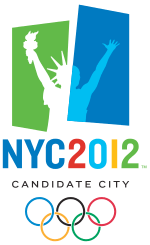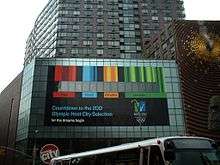New York City bid for the 2012 Summer Olympics
The New York City 2012 Olympic bid was one of the five short-listed bids for the 2012 Summer Olympics, ultimately won by London.
| Overview | |
|---|---|
| Games of the XXX Olympiad XIV Paralympic Games | |
 | |
| Winner: London Runner-up: Paris Shortlist: Madrid · Moscow · New York City | |
| Details | |
| City | New York City, USA |
| NOC | U.S. Olympic Committee |
| Evaluation | |
| IOC score | 7.5 |
| Previous Games hosted | |
| None | |
| Decision | |
| Result | Eliminated in the 2nd round of voting |
New York City's Olympic bid was managed by a private non-profit organization, NYC2012, founded by Daniel L. Doctoroff, then the managing director of Oak Hill Capital Partners, a private equity firm.[1] Doctoroff thought of bringing the Olympic Games to New York after witnessing New York's international sports fans at a 1994 FIFA World Cup match in Giants Stadium. He then built a team to help craft a plan for staging the Games. Seven years later, Doctoroff resigned as President of NYC2012 to join the administration of Mayor Michael Bloomberg, but he continued to lead New York's Olympic Bid as Deputy Mayor for Economic Development and Rebuilding.
Two of the biggest projects proposed as part of the bid were the revival of the East River waterfront, including the construction of an Olympic Village across the river from the United Nations Headquarters and an aquatics center in Brooklyn, and the construction of West Side Stadium, which was supposed to have led to the comprehensive redevelopment of the Far West Side of Manhattan. Other projects that were part of the bid included a rowing course in Queens, a velodrome in the South Bronx, a marina along the coast of the Atlantic Ocean, an equestrian center on Staten Island, and the refurbishment of the historic 369th Regiment Armory in Harlem.
Venues

Olympic venues would have been spread around the city, had it been selected for the Olympics.[2]
Olympic Village
The Village would have been located on the East River Waterfront of Queens across from the United Nations Headquarters. During the Olympics and Paralympics, it would have housed more than 16,000 athletes and coaches. Costing an estimate of $1.5 billion, the Village would include plazas and shops, restaurants, acres of green landscape, training centers and fields, a private dining hall, religious centers, and ferry and train service. Post-Olympic plans would provide world-class residential housing for up to 18,000 New York residents. The area would have designed by Morphosis Architects as the heart and crossroad of New York's Olympic X Plan.
Olympic Square (Manhattan)
- West Side Stadium (Opening/Closing Ceremony, Athletics, Football-Finals match)
- International Broadcasting Center/Main Press Center
- Jacob K. Javits Convention Center along with its expansion (Wrestling, Judo, Taekwondo, Fencing, Weightlifting, Table Tennis)
- Madison Square Garden (Basketball Preliminaries/Finals, Boxing Finals)
- Central Park (Triathlon)
Olympic Park (Queens)
- Olympic Stadium (moved due to refusal of West Side Stadium)
- Flushing-Meadows Corona Regatta Center (Kayaking and Rowing)
- USTA Billie Jean King National Tennis Center
- Water Polo Center
- Archery Stadium near the backdrop of the Unisphere
Olympic Riverfront (Bronx)
- 369th Regiment Armory (Boxing Preliminaries, One Gymnastics Event)
- Yankee Stadium (Baseball)
- Robert K. Kraft Field at Columbia University (Field Hockey Tournament)
- Pelham Bay Shooting and Pentathlon Center
- Queensbridge Athletic Center (Badminton, Cycling)
Elsewhere in the metropolitan area
Brooklyn
- Barclays Center (Gymnastics, Basketball Preliminaries/Finals)
- Williamsburg Waterfront Center (Aquatics, Beach Volleyball)
Queens
- Breezy Point Marina (Sailing, Marathon Start)
Staten Island
- Temporary BMX Stadium
- Greenbelt Equestrian Center (also the Olympic Horse Village)
- Fresh Kills Park (Mountain Biking)
- Fort Wadsworth (Road Cycling)
- Richmond County Bank Ballpark (Softball)
Long Island
- Nassau Veterans Memorial Coliseum (Handball)
New Jersey
- Meadowlands Arena (Indoor Volleyball)
- Giants Stadium (Football Preliminaries)
Elsewhere in the United States (Football Preliminaries)
- Gillette Stadium (Boston)
- Yale Bowl (New Haven)
- Lincoln Financial Field (Philadelphia)
- FedExField (Washington, DC)
West Side Stadium
An Olympic Stadium on the West Side of Manhattan had been part of NYC2012's plan since 2000, when the organization's blueprint for the Games was formally unveiled to the public. Host to Opening and Closing Ceremonies and Athletics competitions, the West Side Stadium would have sat adjacent to the Jacob Javits Convention Center, host to six Olympic sports, Olympic Square Park, and a new 40+ story office tower that would have housed Olympic broadcasters in 2012.
The Stadium's construction was scheduled to proceed regardless of whether New York was awarded the 2012 Olympic Games. The project was to be paid for by the New York Jets ($800 million), New York City ($300 million for infrastructure), and New York State ($300 million for the retractable roof). According to the project's promoters, the building's retractable roof, unnecessary for football, would make the stadium a flexible, multi-purpose facility. It would provide a long-term boost to New York's economy and would jump-start the development of Manhattan's Far West Side.
Local civic groups concerned with congestion and a changing neighborhood had long opposed its construction, and it historically had low citywide approval ratings. The project managed to stay largely out of the media and public spotlight until early 2004 when Cablevision released its first round of advertising against the Stadium. As the owner of Madison Square Garden, which is located just a few blocks from the site of the proposed Olympic Stadium, Cablevision saw the new facility as a potential threat to the Garden's share of concert, convention, and other major event business. [3]
Political opponents of New York mayor Michael Bloomberg, notably the contenders for the Democratic mayoral nomination, used the Stadium issue as a symbol that he was a billionaire who was out of touch with the needs of average New Yorkers. Cablevision spent over $30 million on negative advertising and political lobbying and even generated a competing proposal for development of the Stadium site. However, the Stadium was strongly supported by Bloomberg, who insisted that there was no alternate site for the Olympic Stadium and the project needed to be approved before the International Olympic Committee selected the Host City on July 6, 2005. Finally, on June 6, 2005, the Public Authorities Control Board rejected New York State's $300 million contribution for the project, eliminating the possibility that an Olympic Stadium on that site would be fully approved before the IOC's vote.
The City, working with NYC2012, quickly developed a backup plan, which called for a new ballpark for the New York Mets in Queens in the parking lot of Shea Stadium – later named Citi Field – to be completed for the 2009 baseball season; it was announced on June 12, 2005. The plan would've been to use the stadium for the 2012 Olympics while the Mets would play at Yankee Stadium in the Bronx for that year's baseball season.[4]
Post-bid development
Despite the bid's failure the greatest legacy of the NYC2012 bid has been large-scale development of areas of New York City that underwent rezoning in order to move forward with the NYC2012 bid. Manhattan's Hudson Yards and Brooklyn's waterfront in Williamsburg and Greenpoint both underwent rezoning revisions which were in part due to the region's planned roles as Olympic venues, including the controversial West Side Stadium.[5][6] (The 7 Subway Extension, which was originally planned for the 2012 Olympic bid, was revised to serve the Hudson Yards Redevelopment Project.) The development of the once industrial Queens West neighborhood on the East River may also have origins in the bid, as it was initially slated for development as the planned site of the Olympic Village. Following the Games, the site was to be bought by private developers and converted into condominiums.[7]
Potential 2024 bid
Upon the USOC reaching a new revenue sharing agreement with the IOC in May 2012, New York had been mentioned as a potential candidate for the 2024 Summer Olympics, but Mayor Bill de Blasio decided not to bid in May 2014.[8][9] Los Angeles became the US candidate following the withdrawal of Boston's bid. Los Angeles later secured the right to host the 2028 Summer Olympics while Paris (which competed with New York in the 2012 race) secured the 2024 Summer Olympics.
Citi Field
After the Olympic bid failed, the construction of Citi Field in Queens, now designated as the new home of the New York Mets, went on as scheduled; the Mets played their first game in the stadium in April 2009.
Flushing Meadows Natatorium
Despite the bid's failure, construction of an aquatics center at Flushing Meadow Park went ahead. The Flushing Meadows Natatorium opened in 2008.
Barclays Center
The opening of the Barclays Center (which was the proposed venue for gymnastics) ushered in the return of professional sports franchises to Brooklyn for the first time since the Brooklyn Dodgers left in 1957. The Barclays Center is the home of the NBA's Brooklyn Nets.
Hudson Yards

Despite the failure to approve the West Side Stadium, the site of the West Side Rail Yards still saw development. The Hudson Yards Redevelopment Project saw the construction of multiple buildings and mixed-use developments which has led to the creation of a new neighborhood. The new buildings feature office space and residential space. A shopping mall has also been opened.
Renovations were made to the Javits Center (which would have hosted multiple Olympic events) and the 7 Train was extended to its current terminal at 34th Street. The High Line originates at the Hudson Yards and are an elevated urban park built on former train tracks.
References
- Levy, Nicole; Chiwaya, Nigel (16 August 2016). "How NYC's Failed 2012 Olympic Bid Shaped the City We Live in Today". DNA info. Archived from the original on 26 June 2019. Retrieved 26 June 2019.
- Wiedeman, Reeves (2 August 2012). "What If the 2012 Olympics Had Been in New York?".
- https://ny.curbed.com/2015/1/30/9997132/how-the-new-york-jets-very-nearly-got-a-west-side-stadium
- Levy, Nicole; Chiwaya, Nigel (August 16, 2016). "How NYC's Failed 2012 Olympic Bid Shaped the City We Live in Today". DNAinfo.com. Archived from the original on August 17, 2016. Retrieved August 17, 2016.
- Roberts, Sam (November 26, 2006). "Bloomberg Administration Is Developing Land Use Plan to Accommodate Future Populations". The New York Times. Retrieved 2011-08-07.
- Bagli, Charles V. (November 27, 2011). "From Ashes of Olympic Bid, a Future Rises for the Far West Side". The New York Times. Retrieved 2011-11-28.
- Levin, Andrew (April 27, 2007). "No Olympics, No Problem: New York City's Political Regime after the Bid for the 2012 Games" (PDF). pp. 47–48. Archived from the original (PDF) on 2009-07-27. Retrieved 2011-11-04.
- "IOC agrees revenue-sharing deal with USOC".
- A New York City Olympic Games Considered Archived 2013-10-29 at the Wayback Machine
External links
- Last official site of NYC 2012 from Web Archive
- NYC 2012 logo-unveiling film designed and produced by Trollback + Company
- New York Times article about the bid
- Mitchell L. Moss (November 2011). "HOW NEW YORK CITY WON THE OLYMPICS" (PDF). Rudin Center for Transportation Policy and Management, Robert F. Wagner Graduate School of Public Service. New York University. Retrieved 11 September 2015.
